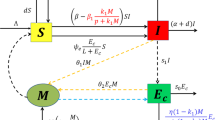Abstract
In this paper, a nonlinear dynamical system is proposed and qualitatively analyzed to study the dynamics and effects of HIV-malaria co-infection in the workplace. Basic reproduction numbers of sub-models are derived and are shown to have LAS disease-free equilibria when their respective basic reproduction numbers are less than unity. Conditions for existence of endemic equilibria of sub-models are also derived. Unlike the HIV-only model, the malaria-only model is shown to exhibit a backward bifurcation under certain conditions. Conditions for optimal control of the co-infection are derived using the Pontryagin’s maximum principle. Numerical experimentation on the resulting optimality system is performed. Using the incremental cost-effectiveness ratio, it is observed that combining preventative measures for both diseases is the best strategy for optimal control of HIV-malaria co-infection at the workplace.


Similar content being viewed by others
References
Adams BM, Banks HT, Kwon H, Tran HT (2004) Dynamic multidrug therapies for HIV: optimal sti control strategties. Math Biosci Eng 1(2):223–241
Agarwala BD (2002) On two ode models for HIV/AIDS development in canada and a logistic seir model. Far East J Appl Math 6(1):25–70
Agraj T, Naresh R, Dillep S (2007) Modeling the effects of screening of unaware infectives on the spread of HIV infection. Appl Math Comput 184:1053–1068
Anderson RM, Medly GF, May RM, Johnson AM (1986) A preliminary study of the transmission dynamics of the human immunodeficiency virus (HIV), the causative agent of AIDS. IMA J Math Appl Med Biol 3:229–263
Baba S, Makinde OD (2014) Optimal control of HIV/AIDS in the workplace in the presence of careless individuals. In: Computational and mathematical methods in medicine 2014. doi:10.1155/2014/831506
Baryarama F, Joseph YTM, Luboobi LS (2005) An HIV/AIDS model with variable force of infection and its application to the epidemic in Uganda. Am J Appl Sci 2:1274–1278
Bertrand JT, O’Reilly K, Denison J, Anhang R, Sweat M (2006) Systematic review of the effectiveness of mass communication programs to change HIV/AIDS-related behaviors in developing countries. Health Educ Res 21(4):567–597
Blayneh K, Cao Y, Kwon HD (2009) Optimal control of vector-borne diseases: treatment and prevention. Discret Contin Dyn Syst B 11(3):587–611
Castillo-Chavez C, Blower S, Driessche P, Kirschner D, Yakubu AA (2002) Mathematical approaches for emerging and reemerging infectious diseases: models, methods, and theory. Springer, New York
Castillo-Chavez C, Song B (2004) Dynamical models of tuberculosis and their applications. Math Biosci Eng 1(2):361–404
Chin J (1990) Current and future dimensions of the HIV/AIDS pandemic in women and children. Lancet 336(8709):221–224
Chitnis N, Cushing JM, Hyman JM (2006) Bifurcation analysis of a mathematical model for malaria transmission. SIAM J Appl Math 67:24–45
Coffee M, Lurie MN, Garnett GP (2007) Modeling the impact of migration on the HIC epidemic in south africa. AIDS 21(3):343–350
Daabo MI, Baba S (2012) Modelling the effect of irresponsible infective immigrants on the transmission dynamics of HIV/AIDS. Adv Appl Math Biosci 3:31–40
Daabo MI, Makinde OD, Baba S (2012) Modelling the spread of HIV/AIDS epidemic in the presence of irresponsible infectives. Afr J Biotechnol 11(51):11287–11295
Essunger P, Perelson AS (1994) Modeling HIV infection of \(\text{ CD }_{4} +\text{ T }\)-cell subpopulations. J Theoret Biol 170(4):367–391
Fleming WH, Rishel RW (1975) Deterministic and stochastic optimal control, vol 1. Springer, New York
Gumel A, Shivakumar PN, Sahai BM (2001) A mathematical model for the dynamics of HIV-1 during the typical course of infection. Nonlinear Anal Theory Methods Appl 47(3):1773–1783
Hethcote HW (2000) The mathematics of infectious diseases. SIAM Rev 42(4):599–653
Jung E, Iwami S, Takeuchi Y, Jo TC (2009) Optimal control strategy for prevention of avian influenza pandemic. J Theoret Biol 260(2):220–229
Lenhart SM, Workman JT (2007) Optimal control applied to biological models, vol 15. CRC Press, Boca Raton
Makinde OD, Okosun KO (2011) Impact of chemo-therapy on optimal control of malaria disease with infected immigrants. BioSystems 104:32–41
Moghadas SM, Gumel Abba B, McLeod Robert G, Gordon Richard (2003) Could condoms stop the AIDS epidemic? J Theoret Med 5:171–181
Mukandavire Z, Garira W (2007) Sex-structured hiv/aids model to analyse the effects of condom use with application to Zimbabwe. J Math Biol 54(5):669–699
Nikolaos IS, Klaus D, Dieter S (1997) Analysis of a model for the pathogenesis of AIDS. Math Biosci 145(1):27–46
Okosun KO, Makinde OD (2013) Analysis of recruitment and industrial human resources management for optimal productivity in the presence of HIV/AIDS epidemic. J Biol Phys 39:99–121
Okosun KO, Makinde OD, Abiodun GJ (2011) Transmission dynamics of HIV/AIDS with optimal control in the presence of carefree suscptibles and treatment, chap. A chapter in BIOMAT book series. World Scientific Publishing Co., Pte. LTd., pp 131–152
Okosun KO, Makinde OD, Takaidza I (2013) Impact of optimal control on the treatment of HIV/AIDS and screening of unaware infectives. Appl Math Model 37:3802–3820
Pontryagin LS (1962) The mathematical theory of optimal processes, vol 4. CRC Press, Boca Raton
Sharomi O, Podder C, Gumel A, Song B (2008) Mathematical analysis of the transmission dynamics of HIV/TB coinfection in the presence of treatment. Math Biosci Eng 5(1):145
Tchuenche J, Garira W, Gumel A, Mukandavire Z (2009) Mathematical analysis of a model for hiv-malaria co-infection. MBE 6(2):333–362. doi:10.3934/mbe.2009.6.333
UNAIDS (2012) Global report: UNAIDS report on the global AIDS epidemic. In: Technical report
Van den Driessche P, Watmough J (2002) Reproduction numbers and sub-threshold endemic equilibria for compartmental models of disease transmission. Math Biosci 180:29–48
WHO (2013) World malaria report. In: Technical report, Geneva 27, Switzerland
Yang HM (2000) malaria transmission model for different levels of acquired immunity and temperature-dependent parameters (vector). Revista de Saúde Pública 34(3):223–231
Author information
Authors and Affiliations
Corresponding author
Rights and permissions
About this article
Cite this article
Seidu, B., Makinde, O.D. & Seini, I.Y. Mathematical Analysis of the Effects of HIV-Malaria Co-infection on Workplace Productivity. Acta Biotheor 63, 151–182 (2015). https://doi.org/10.1007/s10441-015-9255-y
Received:
Accepted:
Published:
Issue Date:
DOI: https://doi.org/10.1007/s10441-015-9255-y




